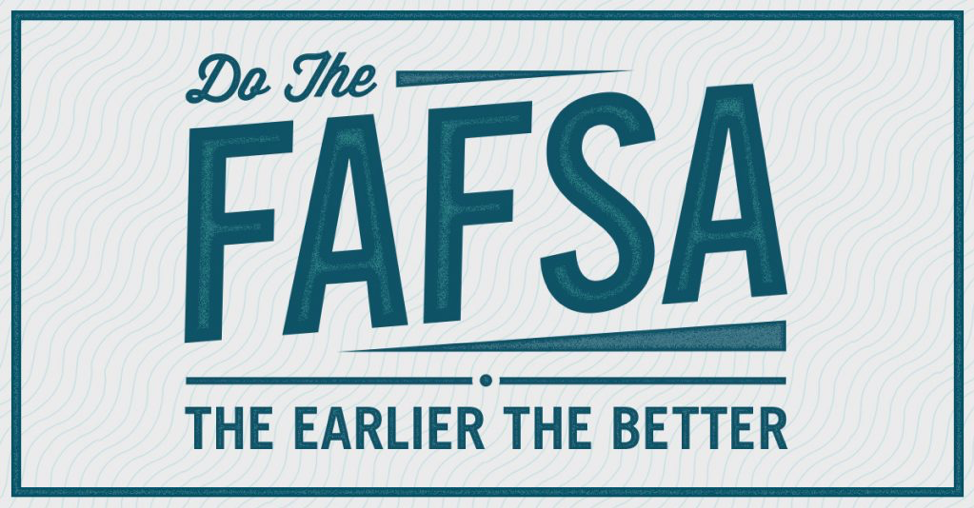October 11, 2019
Financial Aid Timeline by EdMission Possible

Financial Aid 101
Source: Demystifying the Financial Aid Application Process | Edmission Possible
EdMission Possible explores the timeline of being haunted by financial aid as a student.
October marks the beginning of a fun month for kids who are getting their costumes ready for the big day! Not so much for their big sisters or brothers who are college-bound, though. It is far from fun – more like the scariest time of the year – for high school seniors and families with the introduction of two much-dreaded terms they welcome into their vocabulary: the Free Application for Federal Student Aid (FAFSA) and the College Scholarship Service (CSS) Profile.
Much of the college talk suddenly shifts from college applications to financial aid applications. Students who have not even submitted their college applications find themselves even more confused and lost. All of the sudden, they realize that there’s more to going to college than just applying; they actually need money to be able to attend – lots of money!
If they’re not fortunate enough to be sponsored by their families, they come to terms with the harsh reality that they need to find the money elsewhere, but where?
The Three Types of Student Aid
Various financial aid options for students
Source: Demystifying the Financial Aid Application Process | Edmission Possible
Grants and Scholarships
Grants, also known as “gift aid,” refer to free money that doesn’t need to be repaid.
They are need-based, which means that they are awarded to students who demonstrate financial need in their FAFSA applications.
There are also institutional grants, commonly known as “scholarships,” which are awarded on the basis of merit (academic, athletic, and/or special talent.) This means you don’t need to demonstrate financial need to qualify for merit-based scholarships.
Both grants and scholarships go directly towards your college account to pay for tuition, room and board, and other fees, so you cannot use this money for yourself.
Work-Study
Financial aid offered through the federal work-study program means earned money that doesn’t need to be paid back.
Since the funds are disbursed directly to you (think of this as wages), you can choose to use it towards your daily expenses in college as needed.
As much as this is a great opportunity for many college students, it’s not guaranteed money since it depends on the availability of on-campus jobs, as well as the number of hours a student can work each week.
Loans
Loans refer to borrowed money that must be paid back with interest. Student loans, as the name suggests, are disbursed directly to the college, which means that you can’t spend this money for your personal expenses.
You must be extra careful before accepting to borrow loans since you’ll graduate from college with debt – lots of debt, if you don’t know what you are walking into!
There are federal and private loans. I would recommend always exploiting the federal loans first since they have much lower interest rates and better repayment options, as opposed to private loans, which could really break the bank after college.
To qualify for federal aid, institutional grants, and scholarships, you must submit all the required financial aid documents by the designated deadlines. Make sure to check the state, college, and federal deadlines as they will vary.
Note that FAFSA will be required by all the colleges and universities, whereas the CSS Profile will only be required by some private colleges and universities.
To make the process easier for you, I have prepared a financial aid timeline that will help you dramatically throughout the process. I always advise my students to take a print-out of this timeline, tape it on their wall, refer to it often, check off the completed items, and call it a day! Trust me; you will thank me later…
Financial Aid Application Timeline
Financial Aid Timeline: What’s happening and what you need to be doing
Source: Demystifying the Financial Aid Application Process | Edmission Possible
Senior Year: August
- Familiarize yourself with financial aid terms and acronyms. You’ll see them a lot during the next chapter of your life, so the sooner you learn what they mean, the easier the financial aid process will be for you. Here is a full list of financial aid “lingo” that will come in handy for you!
- Research scholarships. Scholarships are free money; they don’t have to be paid back, unlike student loans. Use the College Board’s Scholarship Search tool to find scholarships for which you might qualify.
- Look up colleges’ estimated net prices — net price calculators get updated every year. Pick a college you’re interested in and go to College Search to find its profile. Click Calculate Your Net Price to see that college’s estimated net price for you — the cost of attending a college minus the grants and scholarships you might receive. You can also get this figure by going to the net price calculator on the college’s website.
- Identify financial safety schools and add them to your college list.
- Look up deadlines. Don’t miss the priority deadlines for your colleges’ financial aid applications — meeting these will help you get as much money as possible. You can compare deadlines for different colleges by using the College Search tool. Make sure to find out the application deadlines of any private scholarships or loans for which you plan to apply.
- Find out if you need to file the CSS Profile. A college may require students to complete this application — or the college’s own forms — to apply for financial aid awarded by the institution. You can check the list of the colleges that require CSS Profile on College Board’s website.
Senior Year: September
Do the FAFSA – the earlier the better
Source: Demystifying the Financial Aid Application Process | Edmission Possible
- Apply for national and local scholarships.
- Create an FSA ID (for the parent) here.
- Create an FSA ID (for the student) here.
- Request a tax transcript on the IRS website in case your application is selected for verification. Every year, many students report their financial aid application has been selected for verification. If that happens to you, don’t panic! It’s a very common stage in the process, so you need to be prepared well in advance. Obtaining a tax transcript earlier in the process will save you a lot of time and will give you the chance to submit it to your colleges as soon as they ask for it.
Senior Year: October
- Continue applying to national and local scholarships.
- Complete and submit the FAFSA starting Oct. 1.
- Review Student Aid Report (SAR) and see your Expected Family Contribution (EFC).
- If you see an asterisk (*) next to your EFC, this means that your financial aid application has been selected for verification. Send the tax transcript that you have obtained from the IRS to the colleges that request it, and the problem should be solved.
- Complete and submit the CSS Profile starting Oct. 1.
- Have your non-custodial parent complete and submit the Noncustodial CSS Profile Form (if applicable).
- Request a Noncustodial Parent Waiver Form (if applicable).
- Complete all other additional financial aid forms as requested by each college (such as IDOC, institutional forms, etc…).
Senior Year: November through February
- Continue applying to scholarships.
- Check the application portal of each college that you have applied to in order to see if there are any outstanding financial aid application requirements you need to satisfy or any missing forms you need to submit. If there are, submit them as soon as possible.
- If there have been any significant changes since you filed the FAFSA, contact the Financial Aid Office of each college and notify them of the change. Ask them what you need to submit as proof of the current situation.
Senior Year: March through April
You’re accepted!
Source: Demystifying the Financial Aid Application Process | Edmission Possible
- Congratulations, you did it! Be very proud of all your acceptances, take a deep breath, celebrate, and get back on track. Your work is not done, yet.
- Compare your financial aid awards. The colleges you apply to will send financial aid award letters to tell you how much and what types of aid they’re offering you. Use the Compare Your Aid Awards Calculator to make side-by-side comparisons of each college’s aid package. That’ll give you a more accurate picture of the financial aid award you’ve received from each college.
- Contact a college’s financial aid office, if necessary. Financial aid officers are there to help you if you have questions. If your financial aid award is not enough, do not be afraid to ask about other options.
- Select a financial aid package by the deadline. Once you’ve compared the offers, you and your family should discuss which package best meets your needs. Financial aid is limited, so if you don’t accept your award on time, it may go to another student. You can, however, ask for an extension if you are waiting to hear from other schools. Each college will decide if it is able to give you an extension.
Senior Year: May
Deposit now
Source: Demystifying the Financial Aid Application Process | Edmission Possible
- No later than May 1, commit to the college that you’ve decided to attend by paying the deposit. You are now officially a college student! Congratulations!!!
- Complete and submit all the required financial aid paperwork. If loans are part of your financial aid package, you’ll have to complete and submit paperwork to get the money.
- Get ready to pay the first college tuition bill. This usually covers the first semester and is due before you enroll.
If you play the game according to its rules and stick to the guidelines as well as the deadlines, I have no doubt that you’ll come out of this process victorious.
As always, if you slip or trip along the way, make sure to get back up on your feet immediately. You’ve come this far, so just hang in there for a little longer.
If you think this is all getting out of control, just give us a call at +1(732)-640-5550. At EdMission Possible, we are always here for you.
Do not let the FAFSA scare you! Happy Halloween!
Warmly,
Burcak Deniz Cakir
Founder and President | EdMission Possible
Burcak Deniz Cakir
Source: Demystifying the Financial Aid Application Process | Edmission Possible
Burcak Deniz Cakir has a B.A. in Foreign Language Education, an M.A. in English Language Teaching, and an M.B.A., all of which have laid the solid foundation for her professional experiences as an educator.
She completed the College Counseling Program at UCLA in 2019, which is known to be the most prestigious certificate program in the profession. She has previously taught English as a Foreign/Second Language (EFL/ESL) in Turkey and in the U.S. at Virginia Tech, Harcum College, Rutgers University (Newark and New Brunswick Campuses), and Pace University. Having taught EFL/ESL at the college level for 20 years, Burcak can communicate effectively with college-age students from different countries.
She is bilingual in Turkish and English. Her extensive experience with international students from many countries, including but not limited to Turkey, Saudi Arabia, Korea, and China, has given her the opportunity to understand their unique problems that domestic students may not be facing throughout the college admissions process, such as but not limited to extra testing requirements (TOEFL, IELTS), the translation of high school transcripts and recommendation letters, different financial forms and statements required, visa issues, being homesick, culture shock, etc.
Burcak currently lives in Edison, New Jersey with her husband, two daughters, and her four-legged son. In her free time, she can be found spending time with her family, reading (lots!) about college admissions and college essays, watching her favorite movies, getting lost in design magazines, and decorating her house.
Contact Burcak Deniz Cakir
Email: bdcakir@EdMissionPossible.com
Website: www.EdMissionPossible.com
Instagram: @EdMissionPossible
Interested in having content featured in an upcoming blog post or issue of The Burgundy Zine? Head on over to the submissions page!
For all other inquiries, please fulfill a contact form.








